We loved them yeah yeah yeah
February 6, 2014
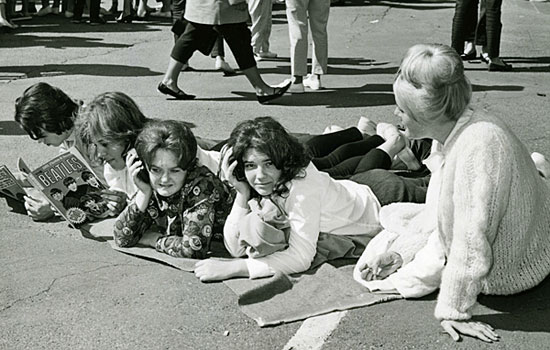
Fans mobbed the Hollywood Bowl for tickets to the Beatles' 1964 Los Angeles debut concert. Photo courtesy of The Music Center Archives/ Otto Rothschild Collection
It was 50 years ago this summer that four lads from Liverpool took the stage of the Hollywood Bowl, ushering in Beatlemania, Los Angeles-style.
Before the end of their 30-minute set on August 23, 1964, this much was certain:
A long-running love affair between the Beatles and Los Angeles was underway. Initially it involved mass hysteria, stealthy getaways, partying with local swells and celebrity hobnobbing on the Sunset Strip. Eventually it blossomed into “Breakfast with the Beatles,” a record label romance, a song, an uncomfortable meeting with Elvis in Bel-Air, even a Tower Records commercial.
At the same time, the Bowl itself was experiencing an electrifying new chapter in its fabled history, as a generation of screaming teenagers converged on the place where their parents had thrilled to popular stars like Frank Sinatra and classical music greats like Jascha Heifetz and Vladimir Horowitz.
Suddenly, it was a whole new ballgame.
“I think that night in 1964, that’s the most famous concert in American history, not counting Woodstock,” said Bob Eubanks, then a 26-year-old Los Angeles deejay and owner of two “Cinnamon Cinder” nightclubs, who produced the Beatles show by mortgaging his house for $25,000. “The boys at the Hollywood Bowl told us we couldn’t sell this thing out in one day, that it was physically impossible. Well, we sold it out in 3½ hours—without computers, by the way—and away we went.”

Paul McCartney backstage at the Bowl in '64. Photo courtesy of The Music Center Archives/ Otto Rothschild Collection
Along with thousands of smitten schoolgirls, stars like Lauren Bacall, Debbie Reynolds and Michael Landon turned out for the performance. Gossip queen Louella Parsons had to be relegated to the back benches—“she let us know about that for a long time,” recalled Eubanks, who went on to national fame as host of “The Newlywed Game.”
Ticket prices ranged from $3 to $7. Fans who couldn’t get in climbed trees around the amphitheater as “Twist and Shout,” “Can’t Buy Me Love” and “I Want to Hold Your Hand” rocked the Cahuenga Pass. After the final number, a cover of the Little Richard hit “Long Tall Sally,” the band was whisked away in a tiny compact car and was getting off the 101 Freeway at Sunset Boulevard before the audience knew what hit them. “The kids still thought they were there and they ruined two limos out back,” Eubanks said.
From his vantage point as a deejay at KRLA, the city’s top rock ‘n’ roll radio station at the time, Eubanks had known for months that something big was on its way.
“Suddenly, there were these four guys from England who just changed the world musically,” he said. “Our phones just started to ring off the hook…It started the night they did the Ed Sullivan show, quite frankly. When we heard they were coming to America, the country started to really buzz.”
This year, the buzz is back. With the 50th anniversary of the group’s first appearance on the Sullivan show taking place this Sunday, February 9, there’s no shortage of magazine covers and think pieces analyzing the British Invasion. And the Hollywood Bowl, where L.A.’s adventures in Beatlemania began, this week announced that it is marking the occasion with three “The Beatles’ 50th at the Bowl” concerts in August. (Those aren’t the only ‘60s flashbacks in store at the Bowl, by the way; the summer schedule also includes performances of the musical “Hair”—complete with “simulated drug use” and “brief nudity.” Check out the complete Bowl schedule here.)

Fainting girls went with the territory. Photo courtesy of The Music Center Archives/ Otto Rothschild Collection
Dave Stewart (of Eurythmics fame) will be “ringmaster and musical director” for the August 22, 23 and 24 Beatles shows at the Bowl, which will include yet-to-be-announced special guests and a re-creation of their original musical set from 1964.
Eubanks said he’d like to take part in the shows if possible. As the 50th anniversary approaches, he has also reached out to Paul McCartney. In an email reply, read by Eubanks in a telephone interview this week, the former Beatle demurred about his availability on the anniversary date but sent along reminiscences of the “heady days of our early trips to L.A.” and this message to fans:
“It was a fantastic time for us and I still have many memories of the things that we got up to. It was great to play the Hollywood Bowl even though our music was completely drowned out by the screams of our lovely fans.”
The Hollywood Bowl Museum is gearing up for the occasion as well. Carol Merrill-Mirsky, museum and archives director for the museum and the Los Angeles Philharmonic, which operates the county-owned Bowl, has commissioned a 3-D model of the Beatles in concert. It will be showcased this summer along with the small cache of Beatles memorabilia—including a copy of Eubanks’ contract for the 1964 concert—that’s on regular display.

Tickets for the 1964 show sold out in 3½ hours. Photo courtesy of The Music Center Archives/ Otto Rothschild Collection
She also has been combing through old pictures from the Music Center archives to put on display—although there are not a lot of images in the collection from that initial concert. She thinks that’s because, aside from Eubanks, few saw the magnitude of what was about to unfold that night.
“He had an instinct that it was going to be huge but nobody else did. Nobody. Certainly the Bowl didn’t, and the fact that we have so few photographs is proof that it was not a big deal. But it was a big deal to the fans—to those teen fans.”
Despite the frenzy among local teens, not everyone was thrilled to see the Fab Four arrive in Los Angeles in 1964. “They wanted to stay at the Ambassador, but the Ambassador didn’t want ‘em,” Eubanks remembered. A house in Bel-Air, complete with “a pool and the whole nine yards,” was lined up instead.
On the night of the concert, a busload of marshals showed up at the Bowl, ready for deployment to “protect the neighbors up in the hills.” Eubanks thought it was a great idea until he realized he was going to be footing the bill.
As a result, he said, he ended up making only about $4,000 on the 1964 concert. But Eubanks, who went on to produce all of the Beatles’ L.A. concerts—two performances at the Hollywood Bowl in 1965 and a 1966 show at Dodger stadium—did “quite well, thank you” on the later gigs.
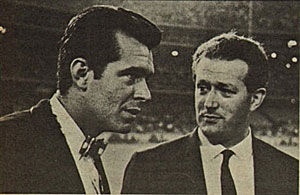
Eubanks, with Beatles publicist Tony Barrow at Dodger Stadium in 1966, witnessed the band's evolution.
He also had the priceless experience of seeing the band’s three-year evolution—from “wide-eyed and curious” in 1964 to seasoned “road warriors” in 1965 to “very difficult” in 1966.
After the last-ever Los Angeles show in 1966, he remembers arguing with John Lennon in the Dodgers’ dugout after the original getaway car failed to make it out of the stadium.
“We got into it pretty good with John down there because he wanted to get to a party. ‘You’ve gotta get us out of here.’ We went nose to nose. And finally I said, ‘I’ll get you out of here.’ We went upstairs and put them in the back of an ambulance.”
The driver “was nervous as heck. He drove right down through 40,000 people…he hit a speed bump and the radiator fell out of the ambulance.”
Finally, they reached a rendezvous point with an armored car that was intended to complete the trip away from the stadium. But it was mobbed with teenage girls and the Beatles’ escape seemed to be foiled again.
“And all of a sudden, I have no idea where they came from, the Hells Angels showed up,” Eubanks said. “They circled the armored car, the kids backed off, and the Hells Angels led the Beatles from Dodgers Stadium. And that was the last time I saw the Hells Angels or the Beatles.”
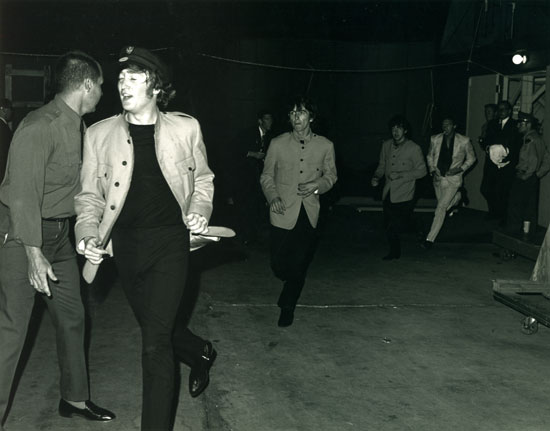
Running into the Bowl in 1965. Photo courtesy of The Music Center Archives/ Otto Rothschild Collection
Posted 2/6/14




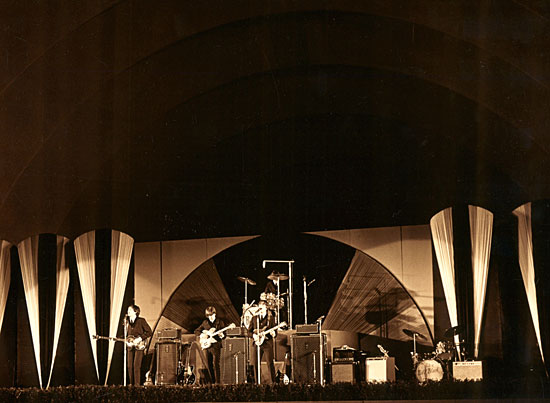
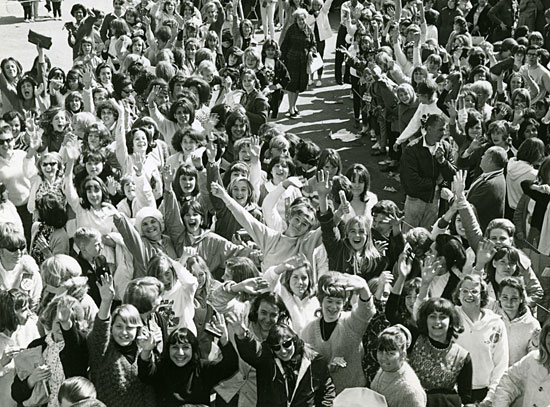










 405 bridge work causes a stink
405 bridge work causes a stink